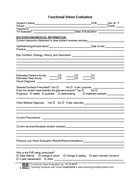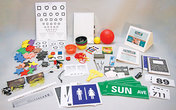- Home
-
Learn
- History of VI >
- Legislation & Laws >
- Vision Professionals >
-
VI Program Resources
>
- Program Printables
- Itinerant Teaching Tips
- Year at a Glance
- VI Program Handbook
- Caseload Analysis
- Organization & Time Management
- Professional Development
- Teacher Standards
- Professional Ethics
- Awards & Recognition
- APH Scholar Program
- Professional Organizations
- Certification Organizations
- Dealing with Challenges
- Professional Publications >
- Relatable Books for All Ages >
- Family Resources >
- Plan
- Basics
-
Teach
- Teaching Strategies >
-
Compensatory Skills Instruction
>
-
Social Skills
>
-
Self Determination
>
- Body Image & Acceptance
- Making Personal Goals
- My Vision Presentation
- My Self-Description
- Create a Personal Data Sheet
- Disclosure Decision
- Disability Statement
- Requesting Help
- Fighting Fears
- My Circle of Support
- Personal Responsibility
- Advocate for Safe Enviroments
- Having Picture Taken
- Coping with Change
- Aging Eyes
- Physical Characteristics
- Political Activism
- Laws Regarding Persons with Disabilities
-
Sensory Efficiency
>
-
Independent Living
>
- Orientation & Mobility Instruction >
- Recreation & Leisure >
-
Career & Vocation
>
-
Grow
- Complete Set Bonus >
-
Recorded Presentations
>
- Webinar: Tips for Being a "Physically Fit" TVI
- Webinar: The Art of Teaching the ECC
- Webinar: Virtual & F2F Strategies
- Webinar: Foundations of Teaching the ECC in the Age of Virtual Instruction
- Webinar: Itinerant Teaching Strategies
- Webinar: Using Themes to Teach the ECC
- Webinar: Conducting a FVLMA
- Webinar: Selecting the Right AT
- Webinar: Developing SMARTER Goals
- Webinar: Determining Service Intensity Using the VISSIT
- Webinar: Activities to Teach the ECC
- Webinar: Accessible Content for BLVI
- Webinar: Accommodations for VI
- Webinar: MIMO Strategies & Activities
- Webinar: SIDPID Strategies & Activities
- Webinar: Standard Course of Study Strategies & Activities
- Webinar: Job Tasks for Job, Career & Life
- Shop
- Jobs
What is the FVLMA?By: Carmen Willings
teachingvisuallyimpaired.com Updated April 7, 2024 The Functional Vision and Learning Media Assessment, conducted by the Teacher of Students with Visual Impairments (TVI), is important to determine what enhancements and adaptations may be helpful to maximize the visual potential for each student. When part of the initial evaluation, the TVI will assess how a student is able to perform visually in a variety of environments that are familiar and unfamiliar. Prior to conducting the FVLMA, a review of background information on the student's eye condition and medical treatment will be conducted. It is essential to obtain a current eye report (within the past year) as vision can change dramatically over time as well as the student's cognitive abilities and ability to cooperate during the assessment. The FVLMA will include a functional evaluation of the students's peripheral fields; color and contrast discrimination; near and distance acuity and discrimination; light sensitivity and preference; visual motility and will also include recommendations for instruction and accommodations. The FVLMA should be conducted prior to other assessments so that other team members are able to consider visual factors before conducting their assessments.
What is the purpose of conducting the Functional Vision Evaluation?A functional vision evaluation (FVE), also called a functional vision assessment (FVA) is an evaluation of the day-to-day visual skills of an individual who is visually impaired. A Functional Vision Evaluation is a legally required document. The purpose of the Functional Vision Evaluation is to supplement the results of the clinical eye exam with descriptions of the student's observable behaviors that may relate to vision. Unlike a clinical eye exam, the purpose of an FVA is not to diagnose a medical condition or to prescribe a therapeutic treatment such as patching, surgery, or medication, but is to determine how the students vision impacts their education. This includes what material and instructional adaptations are necessary, and areas in which the student will need to receive instruction.
The FVE identifies the student's range of visual function; determines how much usable vision a student has to perform visual tasks; and identifies priorities and strategies for intervention. The FVE paired with medical information, helps the TVI/O&M describe how each eye condition translates into real life situations and how a medical condition impacts the individual student's functioning in the daily environment. There are students who have no vision, and functional vision reports are required for them, as well. The purpose of the report confirms the absence of vision and presents recommendations on how to modify instruction for the student. Legally, the report must also address, for all students, whether there is need for a clinical low vision evaluation, or assessment for orientation and mobility services. When is the Functional Vision Evaluation conducted?A functional vision assessment is initially conducted to determine the need for services from a Teacher of Students with Visual Impairments. It is also conducted to determine appropriate goals and level of support needed. The FVE is reviewed on an annual basis to ensure the student is being instructed in the proper learning mode and is receiving appropriate accommodations. In addition to an annual review of the FVE, the TVI continually assesses how a student is using their vision through observations in the student’s learning environment as well as through direct instruction.
The TVI will use the information the classroom teacher provides as well as observations and direct interactions to continually monitor the student’s progress and use of vision, and to ensure the student’s learning environment is appropriate. An updated FVE may also be conducted following the clinical low vision evaluation to ascertain the benefits of prescribed optical devices, determine if instruction is needed for new devices, and view changes in visual function that are the result of the clinical evaluation. What is assessed in the Functional Vision Evaluation?The evaluation must be based on observations of a student in a variety of settings, both indoors and out. It should be conducted at different times of day, across different environments, in the situations where the student is going to be asked to learn. Some students, particularly those with multiple disabilities, may need to be observed in a variety of positions since positioning may also impact visual functioning.
The recommendations section of the report presents guidelines on programming. It discusses the kinds of adaptations and modifications that can support learning. This assessment yields information about the impact of a student's visual impairment on learning. It also provides information that will assist in developing interventions and strategies, such as environmental adaptations and sensory motivators that will enhance the student’s use of vision for early learning activities.The report helps determine eligibility for services as a student with visual impairments. Developmental ConsiderationsWhen student's do not communicate verbally, it is necessary to observe other possible physical responses to visual stimuli. It is important to observe eye movements, changes in breathing patterns, turning their head toward sound, movements of an arm or hand toward a stimuli, vocalizing and any changes in body posture. By observing and assessing the student, the TVI can understand the student's ability to express or understand language, their physical stamina, their physical limitations or disabilities, possible medication side effects, and additional time for responding.
Arrange a time to assess the student when the student is quiet and alert and typically at his or her best. For students with complex needs, use strategies to alert or calm the student before assessing. Use movement to alert and to increase attention to the environment; position the student to allow for head control so the student can use his vision. Consider the impact of working with an unfamiliar person. Also consider if the location is familiar and how it may impact the student. Look for signs of fatigue and how it may impact the student's ability to use their vision. The Results of the Functional Vision EvaluationThe results of the functional vision assessment identify factors that help or hinder student performance and provide recommendations to the educational team about how to increase and enhance the student's visual efficiency. The results will identify a student's visual skills with and without optical devices in a variety of environments and with a variety of levels of visual difficulty. Note ways in which visual fatigue or discomfort can be alleviated or minimized. This information will identify visual skills that need to be learned. The results will assist in determining eligibility for vision services and determine if a referral for other assessments such as an assessment by an Orientation & Mobility Specialist or by a Clinical Low Vision Specialist is needed.
FVE Resources
You are welcome to download and use the Functional Vision Evaluation templates and resources that I developed to assist you in conducting the FVE assessment. Sign up for membership with Teaching Students with Visual Impairments and gain access to these resources along with other free VI Program resources.

New Tools and activities for use with Functional Vision and Learning Media Assessment (NewT) is a new product from APH. Everything you need to complete the Observations, Functional Vision Assessment, and Learning Media Assessment sections of the FV/LMA is in this tool kit. Nigel Newt's Portfolios provide sample graphs, maps, dictionary entries, reading samples, diagrams, news clippings, catalogue pages for grade levels K–11. All text is provided in accessible formats.

The Functional Vision and Learning Media Assessment Kit tool (FVLMA Kit) from APH helps practitioners gather, store, track, and analyze information regarding students' functional vision and appropriate learning media. It is a user-friendly instrument that provides a framework for the systematic assessment of a student's visual functioning and needs for adapted educational media. FVLMA Kit: 7-96151-00...$67.00
|
History of Visual Impairments
Professional Practice
Vision Professionals
Professionalism
Teacher Resources
Professional Publications
VI Book Resources
Family Resources
VI Referrals
Medical vision exams
visual diagnosis
fvlma
|
|
Teaching Students with Visual Impairments LLC
All Rights Reserved |
- Home
-
Learn
- History of VI >
- Legislation & Laws >
- Vision Professionals >
-
VI Program Resources
>
- Program Printables
- Itinerant Teaching Tips
- Year at a Glance
- VI Program Handbook
- Caseload Analysis
- Organization & Time Management
- Professional Development
- Teacher Standards
- Professional Ethics
- Awards & Recognition
- APH Scholar Program
- Professional Organizations
- Certification Organizations
- Dealing with Challenges
- Professional Publications >
- Relatable Books for All Ages >
- Family Resources >
- Plan
- Basics
-
Teach
- Teaching Strategies >
-
Compensatory Skills Instruction
>
-
Social Skills
>
-
Self Determination
>
- Body Image & Acceptance
- Making Personal Goals
- My Vision Presentation
- My Self-Description
- Create a Personal Data Sheet
- Disclosure Decision
- Disability Statement
- Requesting Help
- Fighting Fears
- My Circle of Support
- Personal Responsibility
- Advocate for Safe Enviroments
- Having Picture Taken
- Coping with Change
- Aging Eyes
- Physical Characteristics
- Political Activism
- Laws Regarding Persons with Disabilities
-
Sensory Efficiency
>
-
Independent Living
>
- Orientation & Mobility Instruction >
- Recreation & Leisure >
-
Career & Vocation
>
-
Grow
- Complete Set Bonus >
-
Recorded Presentations
>
- Webinar: Tips for Being a "Physically Fit" TVI
- Webinar: The Art of Teaching the ECC
- Webinar: Virtual & F2F Strategies
- Webinar: Foundations of Teaching the ECC in the Age of Virtual Instruction
- Webinar: Itinerant Teaching Strategies
- Webinar: Using Themes to Teach the ECC
- Webinar: Conducting a FVLMA
- Webinar: Selecting the Right AT
- Webinar: Developing SMARTER Goals
- Webinar: Determining Service Intensity Using the VISSIT
- Webinar: Activities to Teach the ECC
- Webinar: Accessible Content for BLVI
- Webinar: Accommodations for VI
- Webinar: MIMO Strategies & Activities
- Webinar: SIDPID Strategies & Activities
- Webinar: Standard Course of Study Strategies & Activities
- Webinar: Job Tasks for Job, Career & Life
- Shop
- Jobs

